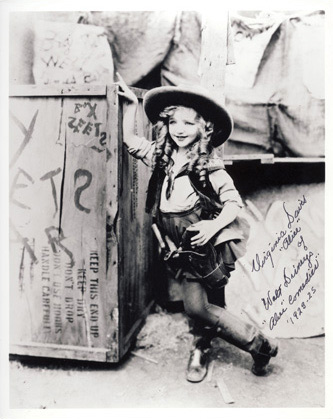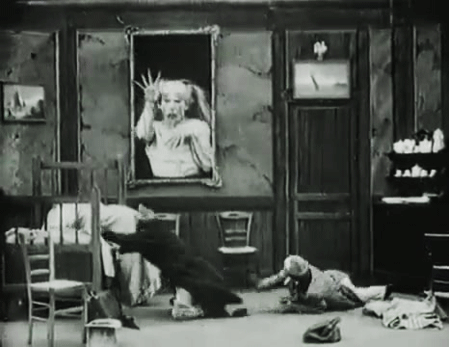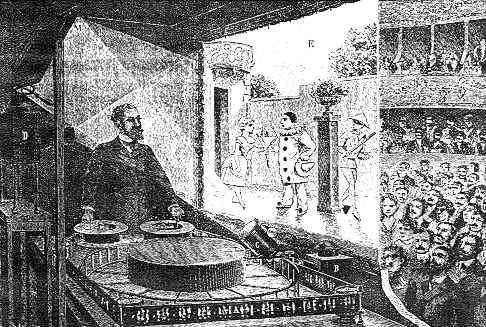Kirsten Anderberg's ANIMATION Blog
OCT. 14, 2014:
WWII: Animators Recruited by U.S. Govt.
The "U.S. Army Air Forces First Motion Picture Unit" produced animated shorts for the military during WWII. Learn more about them from the U.S. National Archives in this short historical film on YouTube at https://www.youtube.com/watch?v=Lpz1rBd6UDU
OCT. 13, 2014:
UPA's "Gerald McBoing Boing"
Somehow it is not surprising that Dr. Suess had a hand in the making of Gerald McBoing Boing...
Gerald McBoing Boing is a kid who only speaks in sound effects!! This cartoon was originally from a Dr. Suess book, and then made by UPA into animated shorts. This series won an Academy Award in 1950. Check out their minimalist drawings to convey animation. Their style is very unique. I love how they made a doorway appear and someone walk into it in such an odd fashion. Watch some of these shorts on YouTube: https://www.youtube.com/watch?v=rDCwg0Xcji4
OCT. 12, 2014:
Technicolor and Disney Team Up
In the early 1930's Disney made a deal with Technicolor, a new color process, to allow Disney alone to use Technicolor for the first three years of its existence! A grand deal for Disney! The first Technicolor Disney film, the 1932, "Flowers and Trees," continued to take syncopated sounds and music with color cartoons to a higher level. Their signature sounds given to trees, plants and flowers takes hold here too. You hear flowers and trees yawning, etc. It won the first Academy Award for Best Animated Short ever awarded. Seeing this animation reminds me of Frank Zappa's "Billy, the Mountain!"
OCT. 11, 2014:
Silly Symphony Shorts
The Walk Disney Studios really did produce and champion cartoons worthy of the title "high art" early on. You can watch all 75 of the "Silly Symphony" short cartoons put out by Disney in the early Golden Years of Animation, from 1929-1939 on Disney's YouTube channel at https://www.youtube.com/watch?v=j1QkIoLhJio. Their sophistication is truly unique and it is clear why they were leading the animation pack.
OCT. 10, 2014:
Disney Breaks Through With Talkies: "Steamboat Willie"
"Steamboat Willie" was a Disney cartoon made in 1928, by Walt Disney Studios. This was one of the first Mickey and Minnie Mouse cartoons, but what really makes this cartoon special is it is the first to synchronize not only the pictures with music, singing and talking voices, but also with sound effects! The sophistication of "Steamboat Willie" is a far cry from Winsor McCay's "Gertie, the Dinosaur," created just 14 years prior.
OCT. 9, 2014:
Squash and Stretch
"Squash and Stretch" is one of the most important concepts in animation. It basically means that something's volume must remain consistent no matter how it is squashed or stretched. Learn more about "Squash and Stretch" and other principals of animation from some of Disney's legends via Wikipedia at http://en.wikipedia.org/wiki/12_basic_principles_of_animation.
OCT. 8, 2014:
Tessellating Animations
Henrik Frank displays his tessellating animation loops on his site…it is interesting to think of uses for such loops…
OCT. 7, 2014:
Animation History
The Department of Film at the Museum of Modern Art in New York City presented a program in 1969 entitled, "Origins of the American Animated Film." You can see the printed program online which includes not only a short history of animation, but also lists of early 1900's cartoons and animated works being shown. It makes for an interesting historical read!
OCT. 6, 2014:
MORE Ladislaw Starewicz!
Starewicz was an animation genius...
Ladislaw Starewicz is one of my favorite animators. I was happy to find a site with a lot of links to his work! His bizarre animations with dead things that used to be alive are creepy but wildly intriguing. Check his work out!!
OCT. 5, 2014:
Disney's 1937 "Snow White": First Feature Cartoon
On Dec. 21, 1937, Disney released "Snow White." It was his first animated feature film. The film is a huge success. Just like "The Three Little Pigs," Disney develops individual characters for all of the "7 Dwarves" which previously, like the pigs, had been illustrated as nearly identical. The success of this feature film funds the beginning of Disney Studios in Burbank.
OCT. 4, 2014:
Disney's Golden Age of Animation Continues: "Mickey's Trailer" (1938)
Disney's "Mickey's Trailer," 1938
While Disney was expanding into feature cartoons, they kept making Mickey Mouse cartoons. "Mickey's Trailer," distributed in 1938, is a fun little excursion into early animation. New characters including Goofy, Pluto and Donald Duck are also introduced during this period as friends of Mickey.
OCT. 3, 2014:
Disney Releases Its Second Feature Cartoon: "Pinocchio" (1940)
Watch an interesting video about the making of Disney's "Pinocchio!"
OCT. 2, 2014:
Fleischer Brothers: "Screen Song with the Famous Bouncing Ball"
The Fleischer Brothers were competing with the Disney Studios in the early Golden Age of Animation. They produced their unforgettable "Screen Song with the Famous Bouncing Ball" shorts which featured live bands with lyrics, accompanied by a bouncing ball to keep you in time, along with an animated cartoon. Primitive Karaoke! Part of what must have been fun about these karaoke shorts is the band plays and the lyrics are shown so the audience would be singing alone, with the band's accompaniment which must have been a source of much laughter in the theater, I would think! Watch their 1936 "No Other One"
OCT. 1, 2014:
Popeye and Betty Boop
I did not know until recently that Popeye, the Sailor Man was originally introduced to the world in Betty Boop cartoons. Popeye was popular as a comic strip, but was also very popular as an animated cartoon. While I also am bristled by Popeye's plots on the whole, with Olive Oyl just not my cup of tea, but supposedly the Popeye cartoons were novel in their sophistication. Here, in a 1936 "Popeye, the Sailor Man Meets Sinbad the Sailor," realistic shadows, miniature sets and multiplane cameras are used. Watching this cartoon, you can see how the Fleischer Brothers were serious competitors of the Disney Studios!
SEPT. 30, 2014:
The Hays Code Goes Into Effect in 1934
The Hays Code Goes Into Effect in 1934 Cartoons such as "Betty Boop," which was using a lot of jazz, slang, etc., along with Hollywood's motion picture industry were pushing the envelope often politically, thus the Hays Code was enacted in 1934 to censor the industry. The Hays Code banned Hollywood from producing films which mocked religion, had illegal drug use or interracial couples, etc. In 1968, the industry changed from trying to censor film makers to instead warning movie viewers of content via a movie ratings system, i.e. PG, R, etc. Apparently Betty Boop was made into more of a housewife than a jazzy adventurer after this code went into effect. I personally ABHOR Betty Boop, to me she is a sexist icon but she is part of animation history. This "How to Animate a Cartoon" video on YouTube is pretty interesting and straight forward. It details the processes involved with animating your own cartoon.
SEPT. 29, 2014:
The Fleischer Brothers Produce A Feature Cartoon: "Gulliver's Travels" (1939)
Fleischer Brothers' "Gulliver's Travels," 1939
The Fleischer Brothers, upon seeing the success of Disney's feature length "Snow White," also tried their hand at a feature animated cartoon in 1939 with "Gulliver's Travels." You can really see the coming of age of animation watching these early animated features. Although it was a good attempt, "Gulliver's Travels" by the Fleischer Brothers is nowhere near as successful as Disney's "Snow White."
SEPT. 28, 2014:
Hoppity Goes To Town: 1941
The Fleischer Brothers put out another feature cartoon in 1941, entitled "Hoppity Goes to Town." I love that it advertises "atmospheric music" in the beginning! This cartoon follows the life of a bug family…I am sure that the more recent "A Bug's Life" by Disney Studios is familiar with this! LOL!
SEPT. 27, 2014:
Fleischer Brothers' Superman Series
The Fleischer Brothers put out an animated Superman series in 1942 which gained acclaim, even though their studios were on the decline. "The Bulleteers," made in 1942, is considered one of its best animated works due to the clean lines, art nouveau style.
SEPT. 26, 2014:
NYTimes, 1926 on Reiniger's Animations
The NYT speaks of shadows as a delightful medium that people enjoy and writes: "Another compelling feature of the shadow-film is the intrinsically popular nature of this medium of expression. All of us delight in the play of shadows - a delight which has been explained as a heritage from our remote cave-or-tent-dwelling ancestors; a remembrance that lurks in the blood of the primordial forests illuminated by camp-fires and haunted by the slinking shadows of wild beasts. There are things that come back to us again as we lie half-dreaming in an unlighted room and watch the play of firelight on the ceiling or the moving reflections from the street without; or when we see the play of the sun or moon through moving branches or of clouds across a sun-lit landscape. The shadow is but a shadow; it is not even a picture, thought it may embody the human, the demoniacal, the ethereal or the celestial. Its impress upon the retina is distinct and immediate. The eye instantly analyzes expression and emotion of the shadows into their most rudimentary elements, and pantomime may speak more clearly than facial play, especially to the jaded eyes of our metropolitan audiences." The Times then goes on to say that Reiniger has counteracted the usual hardness of silhouettes with the grace of her figures, their subtle movements, and the richness and variety of the backgrounds. They also comment that the slowness of movement in her film lends a dignity to the shadows' movements. The Times also commented that the music which accompanied her "Achmed" film was synchronized to the action and added to the whole experience. The composer, W. Zeller, said he did not just create music for the film but rather aimed to create the music tailored to the film, frame by frame. (Herman G. Scheffauerberlin, New York Times, "New Shadow Film Enriches the Screen," July 18, 1926, p. SM6.)
SEPT. 25, 2014:
Disney CA Adventures Park's Tribute to Animation: Sorcerer's Workshop
Disney CA Adventures, next to Disneyland, in Anaheim, CA, has an interesting tribute to animation at the Sorcerer's Workshop. A walk-through castle is full of interactive displays and lots of magical music that Disney is so well-known for.
SEPT. 24, 2014:
"How to Animate a Cartoon"
This "How to Animate a Cartoon" video on YouTube is pretty interesting and straight forward. It details the processes involved with animating your own cartoon.
SEPT. 23, 2014:
The Magic Lantern or Laterna Magica
A "Magic Lantern" on display at the Indianapolis Children's Museum
The Magic Lantern is a 17th century projection device. It could display animation with mirrors, lens and light and would employ the use of two slides simultaneously, with for instance, a static background but moving image in the foreground. In the late 1800's, people used the Magic Lantern in séances and for magic show illusions. A precursor to Emile Cohl's "Fantasmagorie" which he made in 1908, Etienne-Gaspard Robert, a Belgian magician began to experiment with "phantasmagorias in the 1780's, using the Magic Lantern to "conjure up" spirits and ghosts. He was using two slide techniques to accomplish things like a spirit's head would be floating in air, but he would use another slide above it to move his eyes, etc. You can find a huge amount of resources to study the Magic Lantern online with simple search engines.
SEPT. 22, 2014:
Zoetropes on Vinyl Records!
Check out these Zoetropes made on spinning vinyl records!!
SEPT. 21, 2014:
La Linea or The Line
La Linea was a popular Italian cartoon. Approximately 100 episodes were created in 1969 by Osvaldo Cavandoli. It is an interesting study in how to make emotions and story lines without actual faces or complex drawing…
SEPT. 20, 2014:
Walt Disney's Early Years
Virginia Davis played "Alice" in the 1920's Disney short films...
In 1922, Walt Disney formed "Laugh-O-Gram Films." That company had troubles, and in 1923, Disney was able to sell his Alice series of 6 short films for $1,500 each, getting Walt back on his feet. The Alice movies feature a little girl, Virginia Davis, and her exploits, such as the 1924 "Alice's Wild West Show." Disney made several cartoons before Mickey Mouse found popularity, but they were there right as films began to have sound and thus Disney's use of sound began to revolutionize the before silent cartoon world. The "Silent Era" lasted from 1894-1929, approximately.
SEPT. 19, 2014:
Felix, the Cat
"Felix, the Cat, the wonderful, wonderful, cat - whenever he gets in a fix, he reaches into his bag of tricks!"
"Felix, the Cat" was one of my favorite cartoons as a kid growing up in the 1960's. I liked the way he moved and talked and I liked how he had magic in his bag of tricks. I was not as keen on the world doom guy, that part kind of bored me, but out of the cartoons I remember as a kid, "Felix, the Cat" is one I remember spending many afternoons and Saturday mornings watching as a young kid. I did not realize until recently that "Felix, the Cat" began his popularity in the 1920's! Otto Messmer is Felix's actual creator and said that he analyzed Charlie Chaplin's movements in "The Little Tramp," frame by frame, and modeled Felix's movements from Chaplin's movements. This creation secret gave Felix a unique look. Watch the 1927 cartoon, "Felix, the Cat Dines and Pines," a short of almost 8 minutes.
SEPT. 18, 2014:
Max and Dave Fleischer and Koko, the Clown
Koko the Clown was a creation of the Fleischer brothers, and he was a character created to highlight their invention, the Rotoscope. The Rotoscope, a precursor to computer animation, used actual photos of people doing things to translate them into cartoons/drawings, which lent a quirky realism to the cartoons of the clown. The creativity of the Fletschers' story lines made the clown character very popular. Their "Out of the Inkwell" cartoon series includes episodes such as the 1920 "Koko the Clown and the Ouiji Board" and the 1924 "Koko the Clown Takes a Trip to Mars."
SEPT. 17, 2014:
Early Hollywood Animation Studios: Peg System, Cell Animation, Rotoscope
Early Hollywood studios include the Raoul Barre studio, the John Randolph Bray studio and William Randolph Hearst's International Film Services. These studios put out animated shorts and used newspaper comic strip illustrators, and characters, often in their attempts to make cartoon features. "Krazy Kat" is one of the cartoons which tried to make a transition from newspaper comic strip to animated cartoon. Watch Krazy Kat's 1916 short, "Krazy Kat Goes A-Wooing..." Looking at these cartoons I am immediately reminded of "Tom and Jerry" cartoons from the 1960's when I was a child. This 1926 "Mutt'n'Jeff" cartoon is another cartoon produced by studios which was originally a comic strip in newspapers. These comic strip cartoons relied on comic drawing technology more than film technology yet in little time, advances began to take hold. In 1915, Raoul Barre, of Raoul Barre Studios, created the "Peg System" which allowed successive sheets of drawings to be "registered" exactly, over each other perfectly, much like the regular sprocket holes Reynaud was using. Cell animation was also developed around the same time, which revolutionized animation as it allowed the artist to isolate out moving scenes above backgrounds which stayed static. No longer did an animator need to recreate the background with the animation repeatedly but could rather draw one background then superimpose cells of moving objects over the background. In the past, the "slash system" also existed where artists would cut out animated objects and put them physically over backgrounds. This system allowed animation to enter an assemply line process of production. The 1915-1921 cartoon series, "Bobby Bumps" was created using cell animation. Watch the 1916 Bobby Bumps at the Circus," by Bray Studios, which was modelled after the old Buster Brown comic strip. Cell animation reigned in studios until very recently, the 1990's, when digital layering and production methods began to replace cell animation. Another important evolution in the animation game came in 1917 with Max and Dave Fleischer's "Rotoscope." Rotoscopes allowed artists to use "motion capture," which was drawing imagery over pictures underneath, creating a more lifelike representation in the drawing. Modern studios use computer animation, placing sensors on humans to record their motions for later digital animation.
SEPT. 16, 2014:
Lotte Reiniger, German Animator
Lotte Reiniger produced animated stories on film using cut paper and shadow puppetry! Her work is amazing!
Lotte Reiniger was born in Germany in 1899 and was fascinated with shadow puppetry. She would put on her own puppet shows, and then worked professionally
on puppet shows, then was admitted to Institute for Kulturforschung in Berlin, which emphasized study in the making of experimental short films and animation. She experimented with frame by frame,
stop-motion puppet animation. She made 6 short films between 1919-1922 with the help of her husband and other avant-garde artists. She created the movie, "Die Abenteuer des Prinzen Achmed," the
"oldest surviving feature-length animated film ever made" in 1926. Her use of shadow puppets and moving ink on the screen reminds me of light shows at Grateful Dead concerts in the 1980's! Reiniger
also used multi-plane camera techniques 10 years before Disney used it. Her career was interupted by WWII, forcing her to move to England, but from the 1950's to the 1970's she continues
to produce her "silhoutte films" for television. I ADORE THIS WOMAN'S ANIMATIONS OF CLASSIC FAIRY TALES!!! Watching the "Hansel and Gretel" film by her, I had flashbacks of gradeschool. We must
have watched that as kids in the 1960's in my gradeschool as I remember it vividly now that I see it. Check out some of her amazing work:
1921: The Star of Bethlehem
1922: Cinderella
1935: Papageno
1953: The Magic Horse
1954: "Däumelinchen" or Thumbelina
1955: Hansel and Gretel
1955: Jack and the Beanstalk
Watch more of her movies on the History of Film Animation Channel...
SEPT. 15, 2014:
Willis O'Brien, 1886-1962 - Animator of the 1933 "King Kong" Movie
Animation and early moving films shared a common history. Both industries were trying to perfect moving pictures to be projected on screens for public viewing. Also, cartoons and animated shorts often accompanied main features in movie houses. Additionally, Hollywood studios were fueling both professions and artists. One of the pioneers of stop motion films was Willis O'Brien. He left home at the age of 11, and was a cartoonist who had an interest in paleontology. His first short film, "The Dinosaur and the Missing Link," about a cave man fighting a dinosaur, got Thomas Edison's attention and Edison then funded many of his film-making adventures. O'Brien's 1925 stop-motion film, "The Lost World," which used rubberized dinosaur models that looked like they breathed in and out. O'Brien was later hired by RKO Studios to use the skills he learned in making "The Lost World," to help create the 1933 hit, "King Kong." The Empire State Building scene in the 1933 "King Kong" is considered one of the most memorable scenes in movie history.
SEPT. 14, 2014:
Fractured Fairy Tales by Jay Ward
Jay Ward's "Fractured Fairy Tales"
Fractured Fairy Tales was created by Jay Ward Productions, an L.A. production company known for its animation of the “Rocky and Bullwinkle Show” but also other cartoon characters such as Dudley Do-Right and George of the Jungle, and many 1960’s commercials for things like Cap’n Crunch and Quisp cereals (and yes, I remember Quisp cereal and ate it!). Jay Ward was raised in the liberal town of Berkeley, CA and went to what is known as one of the more liberal and artistic universities in the U.S., UCBerkeley, where he got his B.A., then went on to Harvard to get his MBA. He was a realtor, even while he was an animator. He had 3 kids and collected masks from Africa with his wife. “Crusader Rabbit” was his first animated series in 1949, and it used a melodramatic-type feel for the humorous set-ups. I think his use of a melodramatic feelings made these cartoons seem a bit more adult humor, and made not only kids feel like they were not being played down to, but I think adults also liked them due to this. Their (Jay Ward, Bill Scott and other writers’) use of irreverent puns also made them a bit more sophisticated than normal kid cartoons and reminded me of Cohl and “the Incoherents.” “Fractured Fairy Tales” and all of Ward’s work, had a lot of political commentary, honestly, akin to the “Simpsons” now. (And coincidentally, I just read that Matt Groening uses “J” as a middle initial to many of his characters on the “Simpsons” in honor of Jay Ward doing the same with his characters in homage to himself). I was not surprised to hear Jay Ward had conflicts due to his controversial material, but it is said it did not bother him. Also, the use of constant sarcasm, often using a breaking of character in mid-show to make a comment directly to the audience, made the show seem more adult too and took you in and out of the cartoon world. Steven Spielberg said upon Jay Ward’s death in 1989, “'It was the first time that I can recall my parents watching a cartoon show over my shoulder and laughing in places I couldn't comprehend.'' That is exactly what I remember too. My mom hated most cartoon shows due to sexism and racism. She LOVED the “Fractured Fairy Tales” and it is also the only cartoon I remember my parents watching and commenting on/laughing at as I watched it too! Ward became agoraphobic, not wanting to leave his house, and he also created his original cartoons while recovering from injury. He was called an eccentric as well.
SEPT. 13, 2014:
1908: The Haunted Hotel by Segundo de Chomón
Segundo de Chomón's "Haunted House"
In 1905, Spanish director Segundo de Chomón created a silent film entitled, "The Electric Hotel," and then in 1908 created "The Haunted House," which was inspired by Blackton's 1907 film, "The Haunted Hotel." When watching these, I could not help but think of animation such as "Nightmare Before Christmas..." "The Haunted House" is so scary and bizarre that it defies description, you just have to watch it! These are good examples of early stop motion film making...
SEPT. 12, 2014:
Trick Photography: The Beheading of Mary, Queen of Scots
One of the first uses of trick photography, was used in the 1895 film, "The Execution of Mary, Queen of Scots." In her execution scene, they replace her for a dummy in the guillotine creating a dramatic effect. You can watch it on YouTube at https://www.youtube.com/watch?v=XgDG_wc19aU.
SEPT. 11, 2014:
Comic Strip Library
Check out the Comic Strip Library. Their website says "The Comic Strip Library is a digital library containing a collection of public domain comic strips. Everything in the collection predates 1923 and is no longer under copyright in the United States."
SEPT. 10, 2014:
Winsor McCay, 1867?-1934
Winsor McCay is most well known for his Little Nemo cartoons. His animated movie, "Little Nemo," which was released in 1911, took 4 years and 4,000 drawings to make. The movie centered on a little boy named "Nemo," and some weird and kind of scary "friends" of his; "a cigar-chomping clown named Flip" and this strange racist blackface character that does not seem to speak, named "Impy." I have to say, those two characters, Flip and Impy, turned me off immediately to this man's work. You can watch a few minutes of Nemo with his "friends" on YouTube at https://www.youtube.com/watch?v=seOGEwx0NfQ#t=33. You can watch another one of McCay's animated shorts, this one named, "How A Mosquito Operates," which was released in 1912, on YouTube at https://www.youtube.com/watch?v=77cn30IeZPU. I like the mosquito one a bit better due to the lack of strange characters for kids...McCay became tremendously famous in 1914 for his interactive vaudeville show called, "Gertie, the Dinosaur." You can view this performance on Archive.org at https://archive.org/details/Gertie. He basically interacts with an animated dinosaur in this act. In 1918, he released "The Sinking of the Lusitania," which was an odd animation documenting the 1915 sinking of the ship "The Lusitania," wherein 2000 passengers heading to London from the United States experienced a direct hit from a German submarine. I won't spoil the story for you, you can watch the animation yourself on YouTube at https://www.youtube.com/watch?v=AYKdXABWaFg. McCay drew on clear cells to make the Lusitania movie and his realism was not surpassed for another 30 years. In 1921, McCay made a movie called, "Dream of a Rarebit Fiend," based on a comic strip, which includes a scene with a flying house! Watch it on YouTube at https://www.youtube.com/watch?v=obnRKhgRFXA.
SEPT. 9, 2014:
Ladislaw Starewicz, 1882-1965
I believe Starewicz is my favorite of the animator pioneers. He was known for pioneering stop motion film, but he also was a master puppeteer, although his puppets were bugs ingeniously wired to be puppets. His weird films are simply inimitable. His 1912 film, "The Cameraman's Revenge," is created using these bizarre bug puppets, and can be seen on Archives.org at https://archive.org/details/TheCameramansRevenge. "The Mascot" is another weird film made by Starewicz, in 1933, and can be viewed on YouTube at https://www.youtube.com/watch?v=DyLHedkQbCw#t=866. Though he was offered lucrative contracts with Hollywood animation studios, he instead devoted his life to independent film production.
SEPT. 8, 2014:
Emile Cohl, 1857-1938

Cohl's 1908 "Fantoche" and 1962 Terrytoons' "Tom Terrific"
A French animator, Cohl was influenced at a young age by art on propaganda posters. Cohl hung out with a group of artists and intellectuals called "The Incoherents." Part of their mission was to make incoherent art...In 1907, Cohl was 50 years old, was well known for his caricatures and drawings, but had not done any animation yet. (That gives some of us older folks some hope!) In 1908, he created the animated cartoon, "Fantasmagorie," which Cohl created by drawing 700 consecutive images using a light box and he filmed the cartoon as well. You can watch "Fantasmagorie" on YouTube at https://www.youtube.com/watch?v=o1d28X0lkJ4. The lead character, "Fantoche," became a prototype for cartoon characters thereafter and one of my favorite cartoons in the 1960's as a kid, "Tom Terrific," looks almost identical to "Fantoche." Cohl had completed 77 films for Gaumont Studios, by 1910, when he left their employment. You can see one of his more surreal cartoons, "Le Cauchemar de Fantoche" on YouTube at https://www.youtube.com/watch?v=gJw0vIsO_no#t=36. Cohl produced about 300 short animated works in his life and 80% of them are lost. Tragically, like so many great artists, Cohl died on welfare, in a hospital in France in 1938 without a penny and forgotten.
SEPT. 7, 2014:
James Stewart Blackton, 1875-1941
Blackton is often called the "father of animation" due to his "trick" photography. You can see an example of his 1900 film, "The Enchanted Drawing" on Archives.org at https://archive.org/details/TheEnchantedDrawing1900. After his work in animation, Blackton began producing films in Hollywood and came to hate trick photography in deference to realism. In his autobiography, he did not mention his early days of animation at all.
SEPT. 6, 2014:
Eadward Muybridge, 1830-1904
Muybridge proved horses are never in this position...
Another pioneer of animation is Eadweard Muybridge. He studied the way humans and animals move, through sequenced photographs. His story is quite interesting and you can see examples of his work (late 1800's) at his online archive at http://www.muybridge.org/. In 1872-73, the late governor of CA, Leland Stanford, paid Muybridge to prove all four legs of a horse are not on the ground at some point when it is trotting, and Muybridge proved it through photography. Later, he spends time in prison for killing his wife's lover, then in 1877, returns to Stanford's land to study the motions of horses through photography. He was also responsible for changing how people illustrated horses. In the past, most illustrations of horses running placed them in a hobby horse position, with two front legs outstretched forward and two back legs outstretched backwards but Muybridge proved horses are NEVER in that position! So, people quit portraying horses in drawings in the hobby horse position after that for more reality in composition. From his photography of horses, he also expanded out to film ostriches, buffalo, and other animals running. He is also known for his photos of Yosemite Valley from 1867.
SEPT. 5, 2014:
5,200 Year Old Iranian Bowl Animates Goat Running
https://www.youtube.com/watch?v=gDqgrjG1Tv4 This YouTube video shows a bowl that was found in the Burnt City in Iran, which is 5,200 years old, and when you spin it, it is animated!!
SEPT. 4, 2014:
Persistence of Vision: A 1936 Film Explains How We See Things
This video from Archive.org, was made in 1936 by the General Motors Company, https://archive.org/details/HowYouSe1936. It is interesting because it explains how what people see lingers in their brain past the time the object is physically within their vision and how that plays into animation.
SEPT. 3, 2014:
Cardoza's Thaumatrope
Flip books are an ancient form of animation. Here is a video of Cardoza's Thaumatrope, an early flip book-esque toy... https://www.youtube.com/watch?v=dol1xOW_Qzk
SEPT. 2, 2014:
Zoetropes
Zoetropes became popular as toys in the 1800's. Here is a zoetrope in action on YouTube...https://www.youtube.com/watch?v=5_8fX-N3Ji4#t=12.
SEPT. 1, 2014:
Charles-Emile Reynaud, 1844-1918
Reynaud's "Praxinoscope"
Charles-Emile Reynaud was an important part of animation history. He refined the Praxinoscope in 1879, which eventually led to his "Theater Praxinoscope" in 1892. The Theater Praxinoscope allowed Reynaud to project animated images onto a theater screen using mirrors and lens'. He was also able to project a background behind images, so a drawn picture of a horse could be running in a park background, for instance. He handpainted his work onto long strips of gelatin and he used regular sprocket holes to guide his gelatin strips through his machine. It is easy to see how Hollywood films evolved from his work in this field! His "Theatre Optique" is credited as being the first projected animated cartoon in the world. "Pauvre Pierrot," "Around a Cabin" and "Clown and His Dogs" are some of his early shorts. You can watch a video made by Disney Studios about Reynaud's work in animation on YouTube at https://www.youtube.com/watch?v=5xnQSLxJmMg#t=517. Reynaud was very successful showing his full color animated cartoons in theaters, from 1892 to 1900. In the late 1800's, the Lumiere Brothers cut into Reynaud's business severely, by opening a theater a few blocks away from the theater where he showed his animated cartoons, but the Lumiere Brothers were showing films, with actual moving pictures. Reynaud tried desperately to compete with the Lumiere Brothers but he could not figure out 3D imaging. In frustration, in 1912, Reynaud tossed most of his films and equipment into the Seine River! You can watch an 1896 Lumiere Brothers short film, entitled, "The Sprinkler Sprinkled," on YouTube - https://www.youtube.com/watch?v=5HVj7kezK98.
Thank you to Resist.ca for hosting this website!










